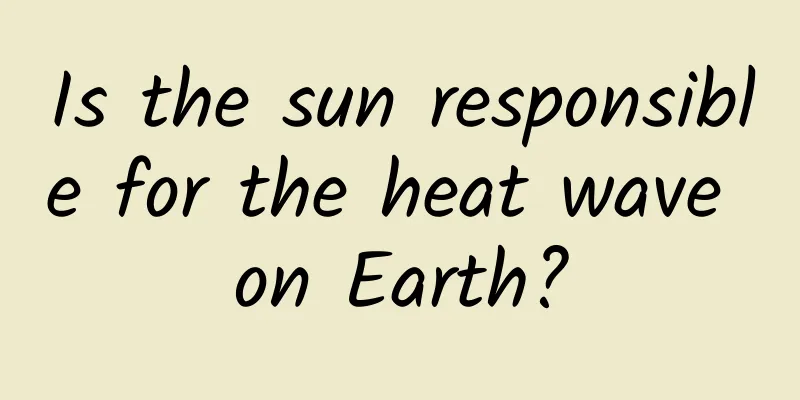Is the sun responsible for the heat wave on Earth?

|
In the summer that just ended, rolling heat waves swept across many parts of the world, and some provinces in my country were also extremely hot. As we all know, the light and heat of the earth come from the sun, and as solar activity becomes increasingly intense, solar eruptions are becoming more and more frequent. So should the sun be responsible for the recent heat waves that have scorched everyone? What are the effects of solar activity on spacecraft? How should astronauts and ground researchers respond? Heat wave blames the sun If you use a telescope with a filter to observe the sun, you will find that sometimes there are some black spots on the surface of the sun. These are sunspots, which are areas where strong magnetic fields gather. It is estimated that the magnetic field strength of sunspots is about thousands of times that of the earth's magnetic field. sunspot The number of sunspots is a sign of the degree of solar activity. The more sunspots there are on the solar surface, the more complex magnetic field structures there are on the solar surface, and the greater the possibility of a solar storm. In the mid-19th century, astronomers discovered the changing pattern of the number of sunspots: in an 11-year cycle, the number of sunspots first increased, then gradually decreased, and finally returned to the level at the beginning of the cycle. Based on historical data, astronomers set 1755 as the starting year of the first solar activity cycle. Of course, the solar cycle is not strictly 11 years, it may be slightly longer or shorter. For example, the 23rd solar cycle from August 1996 to December 2008 lasted 12.3 years, while the previous 22nd solar cycle lasted only 9.9 years. We are currently in the rising phase of the 25th solar activity cycle: after a "silence" around 2019, the sun has become active again, and sunspots have begun to appear in "groups" on the surface of the sun. However, this does not mean that the Sun is to blame for Earth's recent heatwave. In fact, the energy carried by the visible light and infrared electromagnetic waves radiated by the sun all fall into the category of electromagnetic radiation, and the output is quite stable, so you don't have to worry about sudden "explosion" when basking in the sun. Long-term measurements conducted by humans near the earth show that the difference in the radiation power of the sun during the "peak" and "trough" of solar activity is only about 0.1%. Although solar flares, coronal mass ejections and other phenomena occur more frequently during peak solar activity, and radiation in extreme ultraviolet and X-ray bands is significantly enhanced, most of the sun's radiation energy is carried by visible light, infrared and other bands with relatively stable power, and basically does not change drastically with changes in solar activity. Therefore, the causes of the recent extreme weather on Earth still need to be sought from within the Earth's atmosphere. Three "arrows" shot towards the Earth Although the sun does not have to take the blame for the heat waves on Earth, solar eruptions can affect human activities in other ways. There is a complex magnetic field structure above the sunspots. The magnetic field accumulates energy under the action of the solar photosphere, just like an archer tightening the bowstring. When the energy accumulates to a certain level, it will suddenly release, forming solar flares and coronal mass ejections, shooting a large amount of matter and energy on the surface of the sun into space like an arrow from a string. Specifically, violent solar eruptions will shoot three "arrows" into space. The first "arrow" is a strong electromagnetic wave that flies at the speed of light and may hit the Earth 8 minutes after a solar storm erupts, causing abnormal changes in the Earth's ionosphere and middle and upper atmosphere. The second "arrow" is high-energy charged particles produced by solar flares, which may hit the Earth tens of minutes after the solar storm erupts. The energy they contain is enough to penetrate the protective layer of the spacecraft and interfere with the normal operation of the spacecraft's electronic components. The third "arrow" flew slower, giving the Earth 1 to 4 days of "breathing time," followed by coronal matter and the coronal magnetic field it carries, running thousands of kilometers per second. It should be noted that the energy of individual particles in these substances is not as strong as that of the second "arrow," but the coronal magnetic field it carries is like a "key" that can "connect" to the top of the Earth's magnetosphere, open the Earth's "armor," and continuously input matter and energy into the Earth's magnetic field, triggering violent disturbances in the entire Earth's magnetic field, which is a geomagnetic storm. During the super solar storm from October to November 2003, Japan's Earth observation satellite ADEOS-2 lost contact with the ground and was scrapped, and a scientific payload on the more distant Mars Odyssey probe also unexpectedly stopped working and could not be restored. Later investigations found that the "culprit" causing these accidents was the high-energy particles produced by the solar storm. High-energy charged particles bombard electronic devices, which may change the information in the devices, causing abnormal operation of the equipment, forcing the computer that controls the spacecraft to crash, or even completely destroy it. Therefore, when designing a spacecraft, it is necessary to strictly ensure the radiation resistance and electromagnetic protection. "Flying Masters" Beware Compared with the specially treated protective shells of spacecraft such as spacecraft and space stations, astronauts only wear space suits when they go out of the cabin, which has limited protection. If astronauts do not look forward to the weather forecast and choose to go out of the cabin during bad weather, their bodies will be exposed to severe radiation "shocks", which may cause injuries or even threaten their lives. Therefore, astronauts in low-Earth orbit must avoid the time period when the Earth is significantly affected by solar storms when choosing the time for extravehicular activities. When extremely strong solar storms are expected, astronauts on the space station may have to move to better protected modules to avoid them. However, astronauts are not completely safe in the sturdy space station. Countless tiny celestial body impacts may damage the protective shell of the space station, and inadvertent radiation may also threaten the interior of the space station. Astronauts must prepare emergency plans before flying. As we all know, the density of the Earth's atmosphere decreases rapidly with increasing altitude, and at an altitude of hundreds of kilometers in low-Earth orbit, the atmosphere is already quite thin. However, for high-speed spacecraft, the atmospheric resistance here is still not negligible, not to mention that the strong electromagnetic radiation from the sun and geomagnetic storms can cause the atmospheric density in orbit to increase. In 1973, when the United States' first space station, Skylab, began operating in space, scientists expected it to be able to operate in orbit for 10 years. However, due to stronger solar activity than expected, Skylab encountered more resistance than expected, its orbit continued to decline, and it finally fell into the Earth's atmosphere in July 1979, ending its mission ahead of schedule. Skylab In short, the recent unusually hot weather in many places is not caused by increased solar activity, but the space weather changes caused by solar activity will have a significant impact on aerospace technology systems and many aspects of daily life. It is worthy of people's attention, research, and appropriate preventive measures. |
<<: The Chinese people's front teeth are like small shovels. Is it for eating better?
>>: Are invasive alien species necessarily villains?
Recommend
Manufacturers are in a wait-and-see mood as China Media Group pushes its own operating system
"The development, promotion and application ...
Modern climate change: Missing a woman, missing out on a discipline
Science has no national boundaries and no gender ...
Officially "surveying the sky"! Can "Mozi" on a 4,200-meter-high mountain help us see the universe clearly?
Today, at the Lenghu Astronomical Observatory in ...
Chinese scientific expedition team cleverly obtained the "core" from the bottom of Namtso Lake! Ancient climate code at a depth of 400 meters?
Author: Duan Yuechu and Huang Xianghong In the va...
QR code generation and scanning source code download
The QR code generation and scanning function code...
5 pitfalls of brand marketing!
Recently, on some online trading platforms, the p...
Which is bigger, 9/11 or 9/9? A question that a kindergarten kid can answer stumps a bunch of AIs…
Which one is bigger, 9.11 or 9.9? This question, ...
55-inch 4K TV sells for 7999! Is Coocaa T55 a risky move?
How much should an Internet brand TV cost? I beli...
It’s too hot! “Too hot to death” is not a joke. How to prevent it?
Review expert: Wu Xinsheng, deputy chief physicia...
Advertising and marketing promotion, the secret of Thailand’s “tear-jerking” advertisement!
I don't want comfort. I want poetry, I want r...
Taklimakan is not a hopeless situation? The birth of desert ninjas!
Few people can live here for long. Even in today&...
What are the "Fermi Paradox" and the Great Filter Hypothesis? Does the cosmic civilization filter really exist?
After the "Fermi Paradox" about aliens ...
Teach you how to quickly find shortcuts for APP operation and promotion
The eight golden rules introduced in this article...
4 steps for brands to promote live streaming
When brands become immune to entertaining and sen...
Who is suitable to invite Wenchang Pagoda? The most effective Wenchang Tower
After understanding the origin of Wenchang Tower,...









